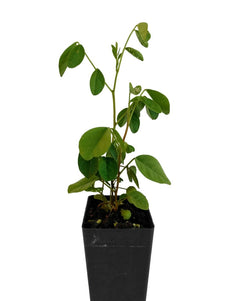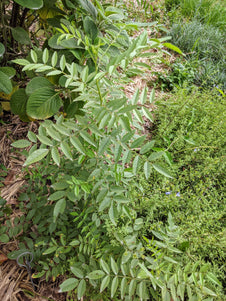



Licorice Plant
Licorice Plant

- In stock, ready to ship
- Inventory on the way

Usually available: October to March
Life cycle: Herbaceous Perennial
Height: 90cm - 1.5m
Position: Full sun
Soil preference: Well drained
This is how we pack and send your Herb Plants to all states except TAS & WA
You will receive
- 1 Licorice Herb Plant in a 50 X 75mm tube - General growing instructions
All of our Herb Plants are grown organically with certified organic potting mixes and fertilizers
Botanical Name: Glycyrrhiza glabra
The licorice root plant is an herbaceous perennial, which requires little maintenance once established. It can reach a height of 90cm to 1.5 meters and has pinnate leaves up to 15 cm long, with 9-17 leaflets. This gives a feather or fern like appearance to the foliage. Short stalks or inflorescences of blue-purple pea flowers appear in late summer, followed by smooth, oblong seed pods. The licorice plant is stoloniferous, which means it spreads by growing new plants, similar to the strawberry plant.
Licorice is easy to grow, but does prefer full sun and well drained soils. The native habitat of licorice is found in both dry, scrubby areas and damp valleys in the Mediterranean and some south-western areas of Asia. It was introduced to England 500 years ago and is now successfully cultivated all over the world.
Licorice has a long history of use for its rejuvenating and nutritious properties. Records show it was being used by Roman legions to build their stamina and by the early Egyptians as a popular drink. It is one of the earliest known remedies for coughs and respiratory conditions and has been used in Chinese medicine for thousands of years. The main active ingredient in licorice root is glycyrrhizin. However, over 600 active components have been identified in the plant, including 10 bioflavanoids which act to strengthen the immune system.
The extract is prepared by boiling the roots and allowing the water to evaporate, resulting in the creation of ‘licorice syrup’. Due to its sweetness and flavour, one use of licorice is to make bitter medicines more palatable. Licorice has many modern and traditional uses as both a medicinal and culinary herb.
Growing Conditions
Licorice grows up to 1.5 m and prefers full sun, but can tolerate part shade. This hardy plant develops a spreading habit, with an extensive branching root system so give it 1-3 meters of space. The roots are brown, straight and wrinkled, with yellow inside. Licorice seed can be sown in spring or summer, but root propagation is more successful. To increase your future licorice crop, plant 20-30cm root pieces with 60-100cm spacing. Once settled, the plants are hardy and will tolerate dry conditions. Roots can be harvested at any time of the year, but may take 2-3 years to reach a worthwhile size of 1-5 cm. The plant will grow in most Australian climates and benefits from added mulch and well drained soils. Since the plant becomes dormant during winter, it is not frost affected.
Companion Plants
The flowering plant, zinnia is popular as a companion to licorice due to its insect attracting qualities. It helps attract pollinators and deters predators. Since it is very hardy, it can grow in the same location as licorice.
Medicinal Uses
The full range of traditional uses for the licorice plant is extensive and it is well known for its action as an expectorant and as a demulcent. Its uses also include treatment for: mucous congestion, tonsillitis, nausea, infertility, menopause and menstrual problems, skin problems, poor circulation, diabetes, fatigue, ulcers and many other conditions. The licorice plant has many medicinal uses and is showing promise in the treatment of heartburn and acid reflux and hepatitis C. It continues to be used for its anti-inflammatory effects in Rheumatoid Arthritis, skin irritations and respiratory infections. There have also been benefits reported for adrenal function in Addison’s Disease.
Culinary Uses
Licorice can be used in drinks or to sweeten fruit when cooking, for example, rhubarb, plums, and other tart fruits. Other herbal tea blends can benefit from the addition of licorice as a flavour enhancer and as a sweetener. Diabetics have also found licorice useful as a sweetener. It also adds flavour and foam to beer, and colour to stout. Licorice root powder is an easy way to incorporate licorice into your cooking or regime.
A cup of chilled licorice tea after meals is a great aid to digestion and a thirst quencher in the heat of summer. One simple licorice tea recipe is to take several licorice roots, cut and washed and place in a pot with at least one litre of water. You can add three slices of ginger if you like the taste. Bring to the boil and let simmer on low heat for 20-30 minutes. You can drink hot or cold several times a week as a general tonic.
A handy hint is to remember that licorice is also spelt liquorice, so when looking for recipes and health benefits on the internet don’t forget to try both spellings!
All information provided on this website is for informational purposes only. Please seek professional advice before commencing any treatment.





